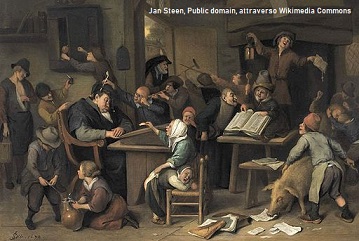E-Learning and Arabic in the Age of Covid-19: Rethinking the Learning of Vocabulary
DOI:
https://doi.org/10.54103/2035-7680/17884Parole chiave:
E-learning; Arabic Vocabulary; TAFLAbstract
Since the beginning of the Covid-19 lockdown in March 2020, Italian universities have been faced with a completely new situation, generally marked by a certain backwardness as regards distance language teaching. This paper describes the impact that distance learning has had on language teaching, particularly on the teaching of lexis in the first year of a three-year degree course in Arabic at Roma Tre University, Italy. Learning vocabulary is a vital part of mastering a language, and experience has shown that students often do not work methodically on this aspect, which leads to problems with listening, speaking, reading, and writing skills. Online teaching has only aggravated this situation and, consequently, new approaches and methodologies are required. This case study presents solutions that have been found in adopting MOODLE, the open-source platform that provides students with a dynamic instrument aimed at facilitating learning. In particular, it describes and evaluates the use of the glossary in MOODLE to help first-year students learn Arabic vocabulary. The students had to add 20 vocabulary items to the glossary each week, and contributions had to follow a certain format that required morphological awareness of the main Arabic lexical structures. The monitoring system whereby the teacher could view student activities further bolstered the learner-centered methodology upon which the whole system is based. Results showed that all students contributed to creating an instrument that promoted independent learning. Overall, the MOODLE glossary was a useful tool for vocabulary learning and recommendations for its successful implementation are reported. This case study will be of interest to language teachers, as well as to learners and instructors dealing with specialized terminology.
Metriche
Riferimenti bibliografici
Abu-Rabia, Salim. “Reading in a Root-Based-Morphology Language: The Case of Arabic.” Journal of Research in Reading, vol. 25, no. 3, 2002, pp. 299-309.
---. “Reading Arabic Texts: Effects of Text Type, Reader Type and Vowelization.” Reading and Writing: An Interdisciplinary Journal, vol. 10, no. 2, 1998, pp. 105-119.
Abu Rabia, Salim, and Linda S. Siegel. “Different Orthographies Different Context Effects: The Effects of Arabic Sentence Context in Skilled and Poor Readers.” Reading Psychology: An International Quarterly, vol. 16, no. 1, 1995, pp. 1-19.
Alqahtani, Mofareh. “The Importance of Vocabulary in Language Learning and How to Be Taught.” International Journal of Teaching and Education, vol. 3, 2015, pp. 21-34, 2015.
Bensoussan, Marsha, and Batia Laufer. “Lexical Guessing in Context in EFL Reading Comprehension.” Journal of Research in Reading, vol. 7, no. 1, 1984, pp. 15-32.
Bonaiuti, Giovanni. “Tecnologie nel contesto di apprendimento. In che modo possono agevolarlo”. Le tecnologie innovative, edited by Giovanni Bonaiuti et al., Carocci, 2017, pp. 197-202.
Bourisly, Ali K., et al. “Neural Correlates of Diacritics in Arabic: An FMRI Study.” Journal of Neurolinguistics, vol. 26, no. 1, 2013, pp. 195-206.
Brown, Philip S. “Innovating a Vocabulary Learning Strategies Program.” Innovating EFL Teaching in Asia, Palgrave Macmillan, 2012, pp. 135-144.
Cole, Jason, and Helen Foster. Using MOODLE: Teaching with the popular open source course management system. O’Reilly Community Press, 2007.
Costa, Carolina, et al. “The Use of Moodle e-Learning Platform: A Study in a Portuguese University.” Procedia Technology, vol. 5, 2012, pp. 334-343.
Crews, Tena B., et al. “Principles for Good Practice in Undergraduate Education: Effective Online Course Design to Assist Students’ Success.” Journal of Online Learning and Teaching, vol. 11, no. 1, 2015, p. 87-103.
Cutler, Anne, and Dennis Norris. “The Role of Strong Syllables in Segmentation for Lexical Access.” Journal of Experimental Psychology. Human Perception and Performance, vol. 14, no. 1, 1988, pp. 113-121.
Daud, Nadwah, and N.A. Pisal. “Speaking Problems in Arabic as a Second Language.” Gema online Journal of Language Studies, vol. 14, no. 1, 2014, pp. 117-133.
Doughty, Catherine, J. “Instructed SLA: Constraints, Compensation, and Enhancement.” The Handbook of Second Language Acquisition, edited by Catherine J. Doughty and Michael H. Long, Blackwell, 2003, pp. 256-310.
Elgort, Irina. “Deliberate Learning and Vocabulary Acquisition in a Second Language.” Language Learning, vol. 61, no. 2, 2011, pp. 367-413.
Ellis, Nick C. “Selective Attention and Transfer Phenomena in L2 Acquisition: Contingency, Cue Competition, Salience, Interference, Overshadowing, Blocking, and Perceptual Learning.” Applied Linguistics, vol. 27, no. 2, 2006, pp. 164-194.
Ginnis, Paul. The Teacher’s Toolkit. Crown House, 2002.
Goral, Tim. "SPOCs May Provide What MOOCs Can’t", University Business, 2013. https://web.archive.org/web/20160304190607/https://www.universitybusiness.com/article/spocs-may-provide-what-moocs-can%E2%80%99t. Accessed 1 Oct. 2021.
Griffith, Michael E., and Graham Charles. “Using Asynchronous Video in Online Classes. Results from a Pilot Study.” International Journal of Instructional Technology and Distance Learning, vol. 6, no. 3, 2009, pp. 65-75.
Gwilliams, Laura, and Alec Marantz. “Non-linear Processing of a Linear Speech Stream. The influence of Morphological Structure on the Recognition of Spoken Arabic Words.” Brain & Language, vol. 147, 2015, pp. 1-13.
Kolb, Alice Y., and David A. Kolb. “Learning Styles and Learning Spaces: Enhancing Experiential Learning in Higher Education.” Academy of Management Learning & Education, vol. 4, no. 2, 2005, pp. 193-212.
Laufer, Batia. “The Concept of ‘Synforms’ (Similar Lexical Forms) in Vocabulary Acquisition.” Language and Education, vol. 2, no. 2, 1988, pp. 113-132.
Li, Voyce. “Social Media in English Language Teaching and Learning.” International Journal of Learning and Teaching, vol. 3, no. 2, 2017, pp. 148-153.
Moghadam, Soodeh Hamzehlou, et al. “A Review on the Important Role of Vocabulary Knowledge in Reading Comprehension Performance.” Procedia, Social and Behavioral Sciences, vol. 66, 2012, pp. 555-563.
Nation, Paul. “Teaching and Learning Vocabulary.” Handbook of Research in Second Language Teaching and Learning, edited by Eli Hinkel, Mahwah, 2005, pp. 581-595.
Panagiotidis, Panos. “MOOCs for Language Learning. Reality and Prospects.” SITE 2019, 2019, pp. 286-292.
Peeters, Ward. “Applying the Networking Power of Web 2.0 to the Foreign Language Classroom: a Taxonomy of the Online Peer Interaction Process.” Computer Assisted Language Learning, vol. 31, no. 8, 2018, pp. 905-931.
Perifanou, Maria, and Anastasios Economides. “MOOCs for Foreign Language Learning. An Effort to Explore and Evaluate the First Practices.” Proceedings of INTED2014 Conference, 2014, pp. 3561-3570.
Piras, Valeria, et al. Come disegnare un corso online. Criteri di progettazione didattica e della comunicazione, Franco Angeli, 2020.
Randall, Mick. “Second Language Reading Proficiency and Word Recognition: The Concept of Saliency and Its Application Across Different Scripts.” Issues in Second Language Proficiency, edited by Alessandro Benati, Continuum, 2009, pp. 16-31.
Reinhardt, Jonathon. “Social Media in Second and Foreign Language Teaching and Learning: Blogs, Wikis, and Social Networking.” Language Teaching, vol. 52, no. 1, 2019, pp. 1-39.
Romagnoli, Chiara, and Valentina Ornaghi. “Learning Chinese Online in the Age of COVID-19: The Cases of Two Italian Universities.” Teaching the Chinese Language Remotely, edited by Shijuan Liu, Springer, 2022, pp. 85-100.
Rubin, Joan, et al. “Intervening in the Use of Strategies.” Language Learner Strategies: 30 Years of Research and Practice, edited by Andrew D. Cohen and Ernesto Macaro, Oxford University Press, 2007, pp. 141-160.
Saigh, Kholood, and Norbert Schmitt. “Difficulties with Vocabulary Word Form: The Case of Arabic ESL Learners.” System, vol. 40, no. 1, 2012, pp. 24-36.
Sakar, Asim. “The MOODLE Tools for Language Teaching and Learning with an Interactive Approach Paper.” Proceedings in INTED2013 Conference, 4th-6th March 2013, pp. 3914-3922.
Schmitt, Norbert. “Vocabulary Learning Strategies.” Vocabulary: Description, Acquisition and Pedagogy, edited by Michael McCarthy and Norbert Schmitt, Cambridge University Press, 1997, pp.199-228.
Taha, Haitham, et al. “How Does Arabic Orthographic Connectivity Modulate Brain Activity During Visual Word Recognition: An ERP Study.” Brain Topography, vol. 26, no. 2, 2012, pp. 292-302.
Trombetti, Anna Laura, and Alberto Stanchi. Le università telematiche. Cosa sono, cosa offrono, un confronto con l’Europa. I libri di Emil, 2017.
Weerasinghe, Tushani A., et al. “Designing Online Learning Environments for Distance Learning.” International Journal of Instructional Technology and Distance Learning, vol. 6, no. 3, 2009, pp. 21-42.
Dowloads
Pubblicato
Come citare
Fascicolo
Sezione
Licenza

Questo articolo è soggetto a licenza Creative Commons Attribution-NonCommercial-NoDerivatives 3.0 International License.




